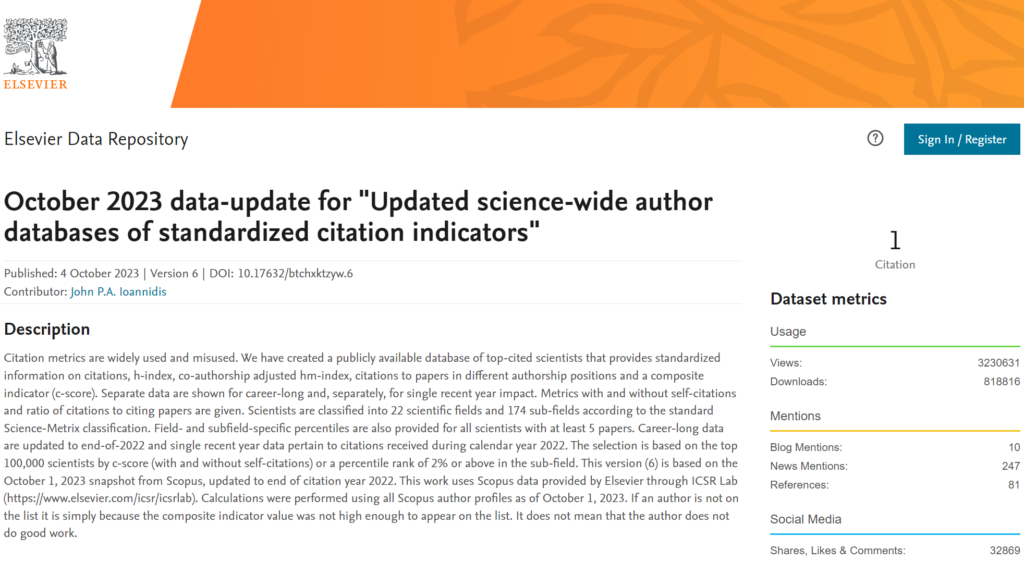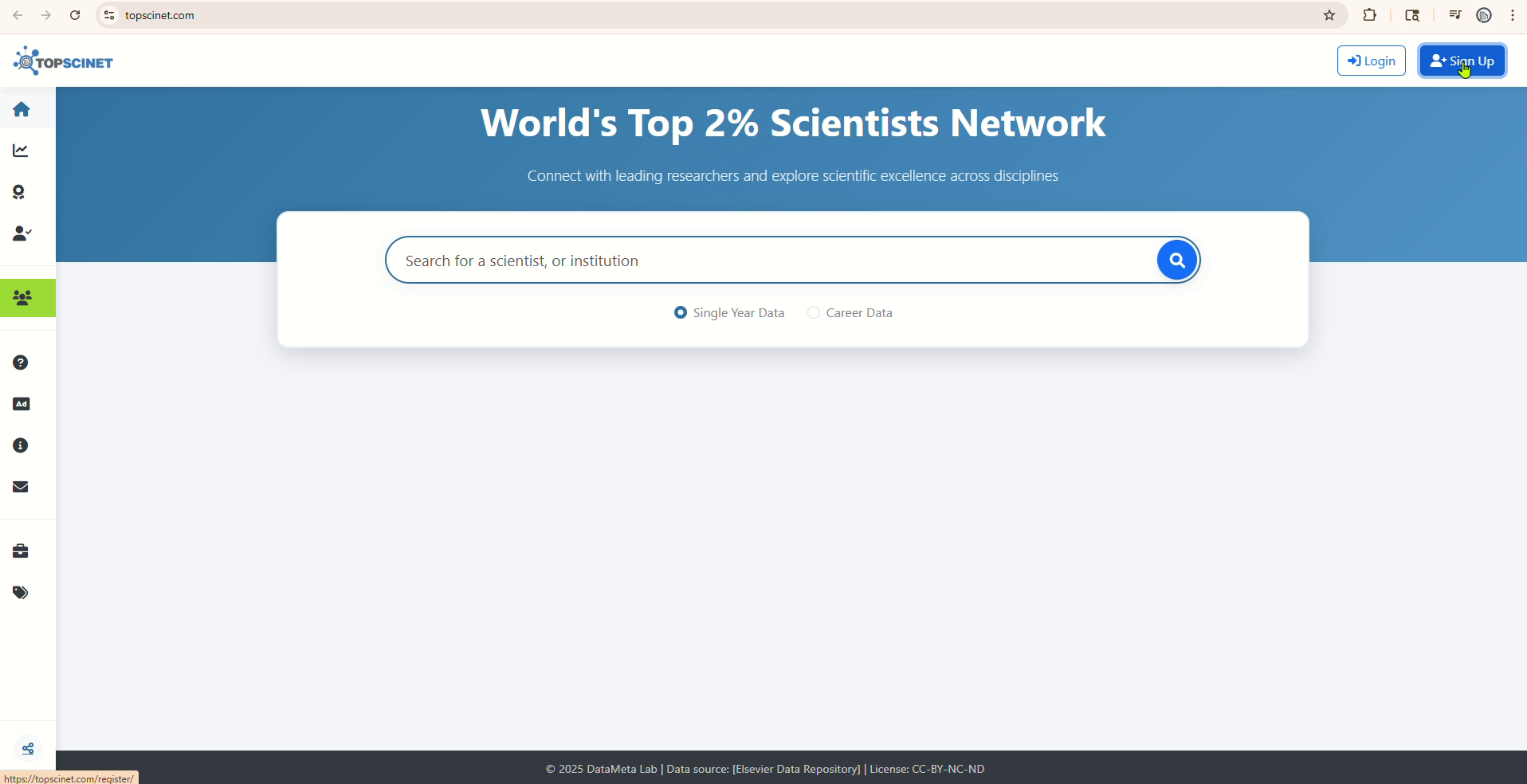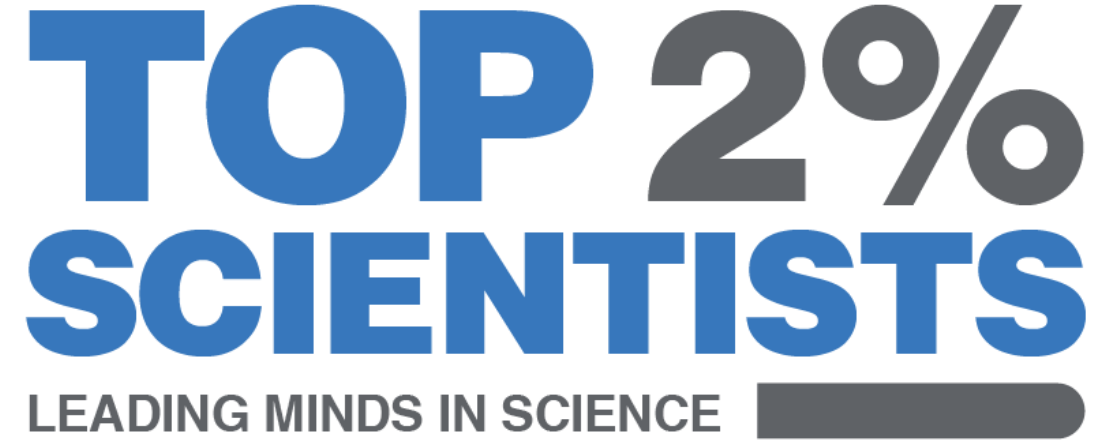Stanford University’s “World’s Top 2% Scientists list” is a prestigious ranking that highlights the most influential researchers across a broad range of scientific fields. Compiled in collaboration with Elsevier and based on data from Scopus, this list serves as a powerful tool for identifying global scientific leaders. But what exactly does it take to be included in this exclusive ranking, and why does it matter?
The Creation of the Top 2% Scientists List
The list, created by Stanford University using Scopus data provided by Elsevier through ICSR Lab (https://www.elsevier.com/icsr/icsrlab). , aims to provide a standardized way to recognize scientists who have made a significant impact on their respective fields. It draws from a variety of citation metrics, such as the h-index, co-authorship, and adjusted citation counts, to ensure fair and balanced representation of researchers. The list is updated annually, with career-long data and single-year impacts for transparency and current relevance.
What Criteria Are Used?
The inclusion in the “Top 2%” list is determined by several key metrics: C-score: This is the composite score based on various bibliometric factors, including the total number of citations, h-index, and the number of citations with and without self-citations. Field and Sub-field Percentiles: Scientists are classified into 22 broad fields and 176 sub-fields. Only those who rank in the top 2% of their sub-field are included. Career-Long vs. Single-Year Impact: The ranking is available for both career-long impact and single-year performance, offering insights into both long-term contribution and recent achievements. You can also read this article that explains what is the Selection Criteria and Methodology of Top 2% Scientists List.
Why Does It Matter?
Being listed among the Top 2% of scientists is a prestigious recognition of one’s contributions to science. It signifies global recognition for research excellence, often boosting a scientist’s reputation in academia and industry. Such recognition can lead to increased opportunities for funding, collaborations, and speaking engagements at international conferences.
Moreover, the ranking offers visibility across disciplines, bringing attention to work that might otherwise remain niche or underappreciated. It also serves as a reference point for institutions and governments to assess the influence of their research programs.

Image Source: Screenshot of Elsevier Data Repository webpage taken on sep 06, 24.
How Does It Benefit Researchers?
For individual researchers, inclusion in the World’s Top 2% Scientists list can significantly elevate their academic profile. It opens the door to greater recognition in their field and beyond, often leading to increased citations, higher chances of collaborative work, and enhanced career opportunities. Many institutions use this ranking to measure the success of their faculty, and being on the list can boost credibility within the academic community.
Additionally, the list encourages scientists to focus on producing high-quality, impactful research rather than simply chasing quantity. It rewards meaningful contributions to the scientific community, which can inspire others to aim for similar recognition.
Controversy Surrounding the Methodology
While Stanford’s “World’s Top 2% Scientists” list has been embraced by many institutions as a reliable measure of research impact, it has also faced criticism from some scholars. Skeptics argue that the methodology, which relies heavily on citation metrics, may overlook the quality of contributions in favor of quantity. Concerns have been raised about the potential for self-citations to inflate rankings, even though the database accounts for citations without self-cites. Additionally, some researchers suggest that relying on metrics like the h-index and c-score may not fully capture the real-world impact or societal relevance of certain studies, leading to debates about the true fairness of the ranking system.
Conclusion
Stanford University’s World’s Top 2% Scientists list is a valuable recognition of scientific excellence and impact. By compiling data from across scientific fields and offering a fair, metric-driven approach, this list not only celebrates individual achievements but also highlights the importance of impactful research in advancing knowledge. Whether you are an academic aiming for inclusion or someone interested in understanding the landscape of influential science, this ranking is a beacon of excellence in a complex and ever-evolving world of research.
Searchable Database for Top 2% Scientists
Visit TOPSCINET.com
If your name appears in the search results, claim your profile using your institutional email to update your social media links and enhance your online presence.




Pingback: Methodology and Selection Criteria of Top 2% Scientists List - Top 2% Scientists
Pingback: How to be Listed in Top 2% Scientists List: A Strategic Guide - Top 2% Scientists
Pingback: How to Access the Stanford University Top 2% Scientists List - Top 2% Scientists
Pingback: Top 2% Scientists Website - Searchable Version - Top 2% Scientists
Pingback: Top 10 Universities Dominating Stanford's 2023 Top 2% Scientists List - Top 2% Scientists
Pingback: Stanford/Elsevier Top 2% Scientists List 2024 - Top 2% Scientists
Want Pdf or Excel list 2024
Dear Tariq,
You can find all the Excel files in this link https://elsevier.digitalcommonsdata.com/datasets/btchxktzyw/7.
Regards,
Francisco Tello-Ortiz.
You are asking for Institution e mail Id to find out my profile in the Top 2% List of Scientists. I was in the top 2% List of Scientists for the last 3 years. But for retired scientists like me, there’s no Institution e mail Id. So what’s the way for me?
Hi Namasivayam Chinnaiya,
It is a check to make sure that a right person is claiming his profile. Otherwise anyone can claim your profile. However if you have a genuine reason (like in your case it is) so send us an email at info@topresearcherslist.com, we will definitely accommodate that.
DR RAJNEESH KUMAR
MATHEMATICS DEPARTMENT, KURUKSHETRA UNIVERSITY, KURUKSHETRA, HARYANA
Pingback: Scientific Fields in Stanford's Top 2% List 2024 - Top 2% Scientists
This list is so sad. Please don’t try to be included.
Why not?
Pingback: John P.A. Ioannidis: Revolutionizing Scientific Rankings - Top 2% Scientists
Hi, is this metric based only on publications in Elsevier journals or does it include publications in all scopus indexed journals?
Pingback: Top 10 U.S. Researchers in Stanford/Elsevier's 2024 List - Top 2% Scientists
Pingback: Top 10 Researchers from India in Stanford/Elsevier’s 2024 List - Top 2% Scientists
Pingback: Top 2% Scientist Certificate: A Step-by-Step Guide on How to Get It - Top 2% Scientists
Pingback: Top Spanish Institutions in Stanford/Elsevier 2024 List - Top 2% Scientists
Pingback: Top 10 Researchers from Malaysia in Stanford/Elsevier’s 2024 List - Top 2% Scientists
Pingback: Top Indian Institutions in Stanford/Elsevier 2024 List - Top 2% Scientists
Pingback: Top 10 Researchers from Australia in Stanford/Elsevier’s 2024 List - Top 2% Scientists
Pingback: Top 10 Researchers from Vietnam in Stanford/Elsevier’s 2024 List - Top 2% Scientists
Pingback: Top 10 Researchers from Egypt - Top 2% Scientists
Pingback: Top 10 Researchers from Palestine - Top 2% Scientists
Pingback: 5 CEE Faculty Ranked in Top 2% of Scientists | School of Civil and Environmental Engineering
Pingback: Top 10 Researchers from Portugal - Top 2% Scientists
Pingback: Top 10 Researchers from Canada - Top 2% Scientists
Pingback: Top 10 Researchers from Morocco - Top 2% Scientists
Pingback: Top 10 Researchers from Italy - Top 2% Scientists
Pingback: Top 10 Researchers from Greece - Top 2% Scientists
Pingback: Top 100 Scientists in Mathematics & Statistics - Top 2% Scientists
Pingback: Top 100 Scientists in Engineering - Top 2% Scientists
Pingback: Top 100 Scientists in Biomedical - Top 2% Scientists
Pingback: Top 100 Scientists in Chemistry - Top 2% Scientists
Pingback: Top 10 Researchers from Brazil - Top 2% Scientists
Pingback: Top 10 Researchers from Spain - Top 2% Scientists
Pingback: DELOX CSO JOÃO PIRES DA SILVA RECOGNIZED AMONG WORLD'S MOST CITED RESEARCHERS - Delox
Pingback: Top 10 Researchers from Algeria - Top 2% Scientists
Pingback: Top Pakistani Institutions in Stanford/Elsevier 2024 List - Top 2% Scientists
Pingback: Top 100 Scientists in Public Health & Health Services - Top 2% Scientists
Pingback: Top 10 Researchers from United Arab Emirates - Top 2% Scientists
Pingback: Top 10 Researchers from South Korea - Top 2% Scientists
Pingback: Top 10 Researchers from Türkiye - Top 2% Scientists
Pingback: 52 professores de engenharia da UConn entre os 2% melhores cientistas do mundo | Azores News
How to apply for to be considered for 2024
Pingback: Top 100 Scientists in Communication & Textual Studies - Top 2% Scientists
Pingback: Top 10 Researchers from China - Top 2% Scientists
Pingback: Top 100 Scientists in Physics and Astronomy - Top 2% Scientists